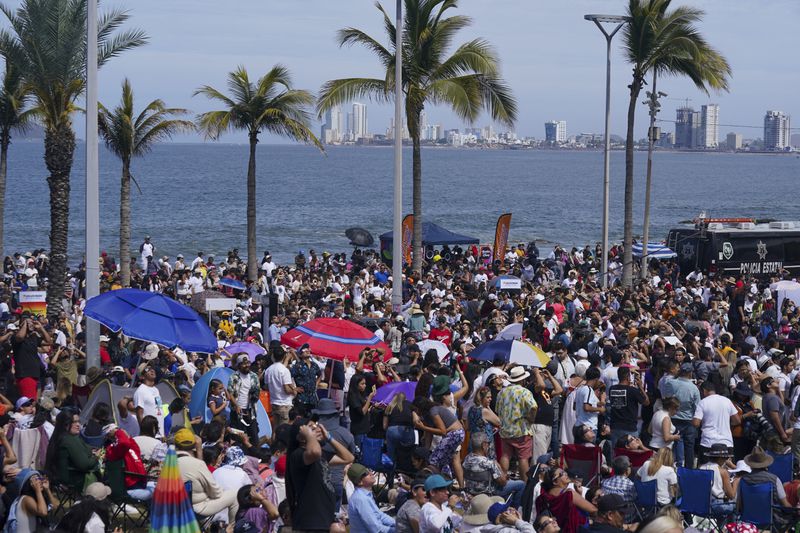A total solar eclipse crossed North America on Monday, darkening skies along a path through Mexico, the United States and Canada.
Here's the latest:
TOTAL ECLIPSE RACES ACROSS NORTH AMERICA
A chilly, midday darkness fell across North America as a total solar eclipse raced across the continent.
Monday’s spectacle was watched by millions in the U.S., Mexico and Canada. It was North America’s biggest eclipse crowd ever, thanks to the densely populated path.
Cloud cover threatened to spoil the view in some places, especially in parts of Texas, but the skies cleared with minutes to spare.
One place that got stuck with clouds: Niagara Falls, New York. Totality arrived to whoops and cheers from spectators at Niagara Falls State Park.
Justin Pape drove 6 hours from York, Pennsylvania, with his family to be in the path. He says “it’s unfortunate it was cloudy" but they still got to see a glimpse of it and it still got dark.
During a total solar eclipse, the moon passes in front of the sun and blocks the sunlight for a few minutes. There won’t be another coast-to-coast spectacle on the continent until 2045.
___
TOTAL SOLAR ECLIPSE EXITS NORTH AMERICA
The sun is reappearing from behind the moon as the total solar eclipse leaves North America. There won’t be another coast-to-coast spectacle on the continent until 2045.
___
DALLAS STUDENTS ELATED BY ECLIPSE
DALLAS – Emergency lights clicked on outside D.A. Hulcy Middle School as the last sliver of the sun disappeared. Students cheered and whooped, sitting on towels and picnic blankets in an adjacent parking lot.
“I’m a new person,” eighth grader Nia Modkins said.
Students and teachers took off their eclipse glasses and pointed at the sky, taking pictures and videos. Once three minutes elapsed, their teachers told them to put their eclipse glasses back on as the sun prepared for its return act.
Once daylight swept over the parking lot again, eighth grader Sky Johnson swiped through her phone, looking for the video she’d taken during totality.
“Two minutes of me screaming, literally,” she said.
By Adithi Ramakrishnan
___
BEACHES GROW DARK IN MEXICO
MAZATLAN, Mexico – Mazatlan’s sparkling beaches have been cast into darkness as the total solar eclipse reaches its maximum coverage.
Hundreds of gathered faces were illuminated only by the screens of their cellphones as they tried to capture the slightly more than 4 minutes of totality.
Palm trees were silhouetted against a faint glow near the horizon like one of the resort’s famous sunsets, but coming before noon.
Karen Ibarra, of Colombia, is a researcher at Mexico’s National Autonomous University. She came to Mazatlan for the eclipse.
As darkness blanketed the coast she said, “seeing the corona is the best.”
___
TOTAL SOLAR ECLIPSE REACHES U.S. ON WAY TO CANADA
The moon’s shadow has moved into the U.S. with cloudy skies in store for a part of the total eclipse path from Texas to Maine.
The eclipse cuts through major cities including Dallas; Austin, Texas; Indianapolis; Cleveland; and Niagara Falls, New York.
___
TOTAL SOLAR ECLIPSE BEGINS IN NORTH AMERICA OVER MEXICO
A total solar eclipse has reached North America over Mexico as throngs gather along the country’s Pacific coast.
It’ll race toward United States and eastern Canada before exiting into the Atlantic.
___
TEXANS THANKFUL FOR BREAKS IN CLOUDS
MESQUITE, Texas – City officials cheered as the thick clouds parted in early afternoon and the sun peeked out, with the moon already taking a bite out of it.
“We special ordered the sun this morning,” said downtown development manager Beverly Abell.
Hundreds gathered at Front Street Station for the outdoor watch party, many pulling out their eclipse glasses to watch the moon’s bite grow ever bigger.
At the Fort Worth Zoo, clouds occasionally moved over as the eclipse started. Zoo patrons stopped along the paths to take it in.
Todd Beeby, 34, drove up with friends from Houston. He said that even with some clouds moving over, the viewing was good.
“It’s kind of neat to see it roll in and out,” he said.
___
CHEERS IN MEXICO AS MOON BEGINS PASSING OVER SUN
MAZATLAN, Mexico – Cheers broke out along the beach in this resort city as the moon began to pass over the sun.
Hundreds in a beachside park had passed the waiting time by readying their equipment and listening to a youth orchestra play Star Wars songs while a large screen projected images of Princess Leia behind them.
Luz Elena Aguillón de la O sat in the grass with a group of 14 family and friends who had gathered from Mexico City, Guanajuato and right here in Mazatlan to take in the spectacle.
“Happy to be here with family, friends sharing a singular, unrepeatable event that the universe and nature give us,” she said.
___
BIDEN ENCOURAGES AMERICANS TO WEAR EYE PROTECTION
WASHINGTON – President Joe Biden posted a brief video on X to encourage Americans to wear eye protection when viewing the eclipse – in a subtle dig at his predecessor and 2024 rival, former President Donald Trump.
“Folks, enjoy the eclipse, but play it safe, don’t be silly,” Biden said in a video showing him donning eclipse glasses and looking skyward from the balcony outside the Blue Room of the White House.
That's the spot where Trump glanced up toward the sun without eye protection in 2017.
Biden is traveling to Wisconsin, which, like Washington, will experience a partial eclipse on Monday.
White House press secretary Karine Jean-Pierre said she had no details to share on whether Biden would view the phenomenon.
___
PARTIAL ECLIPSE BEGINS OVER SOUTH PACIFIC
The moon has started to cover up the sun as a partial eclipse begins over the South Pacific. Millions along a narrow corridor in North America from Mexico’s Pacific coast to eastern Canada hope for clouds to clear as they eagerly wait for totality to reach their location.
___
MEXICAN BEACH TOWN IS FIRST IN LINE FOR TOTALITY
MAZATLAN, Mexico – Valeria Rosas says her four kids had been so excited by an October partial solar eclipse that passed over southeast Mexico, that she decided to come to this Pacific coast beach city for Monday's total eclipse.
The 32-year-old drove eight hours from Leon, Guanajuato, with 10 friends and relatives.
They joined hundreds of others in a beachside park under blue skies streaked with wispy clouds. It’s the first part of North America that will get to see the total eclipse.
Rosas’ mother, Carmen Loza Rodríguez, recalled that Rosas was a baby when Mexico last saw a total solar eclipse in 1991.
“How cool that we have the opportunity to experience it in this digital age, that we can share it with the world,” Rosas said.
___
SPECTATORS ARRIVE EARLY AT NIAGARA FALLS
NIAGARA FALLS, New York — The main attraction at Niagara Falls is typically the more than 750,000 gallons of water that rush over the brink every second. On Monday, it was the eclipse.
Tourists streamed into Niagara Falls State Park with wagons, strollers, coolers and chairs. Photographers’ tripods lined a railing under cloudy skies.
Synthia Nguyen and Jen Cerna from Washington, D.C., claimed a prime lawn spot along the rapids, arriving at 6 a.m. with chairs, a blanket and a tent — that they were quickly asked to take down.
They were excited that totality would last a few minutes, long enough for it to sink in.
The pair work in an ophthalmology office.
“We’re expecting a lot of calls tomorrow,” Cerna said.
___
WILL THERE BE CLEAR SKIES?
The weather isn’t looking good for a large part of the eclipse’s path. Clouds could get in the way for a stretch of the route, with the heaviest clouds expected in parts of Texas.
There are patches that may be clear. And meteorologists point out that the eclipse might still be visible if the clouds are high and thin.
The one area where clear skies are expected is northern New England through to Canada.
That area has “a pretty solid lock to be able to see the eclipse pretty crystal clear," said National Weather Service meteorologist Cody Snell.
Fifteen U.S. states get a chance to see the full eclipse, although just a small bit of Tennessee and Michigan are included. The length of totality varies by location.
The moon’s shadow that falls on Earth follows along a path that is 115 miles wide. Practically everyone in North America will have a chance at catching at least a partial eclipse. The farther from the path of totality, the smaller the moon’s bite will be out of the sun.
___
CITIES AND TOWN BRACE FOR CROWDS
Small towns and rural communities along the eclipse path are steeling for huge crowds.
Tourism and community leaders from Texas to Maine trucked in extra fuel and port-a-potties, and urged residents and visitors to be prepared — and to be patient.
Some counties have issued disaster declarations to get extra help with policing and other aid, similar to the aftermath of severe storms.
Among them is Kerr County, located about 65 miles northwest of San Antonio, where the normal population of 53,000 is expected to double or triple.
___
The Associated Press Health and Science Department receives support from the Howard Hughes Medical Institute’s Science and Educational Media Group. The AP is solely responsible for all content.
Credit: AP
Credit: AP
Credit: AP
Credit: AP
Credit: AP
Credit: AP
Credit: AP
Credit: AP










